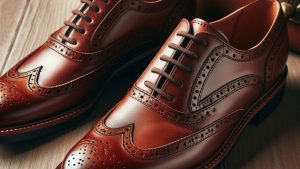Table of Contents
ToggleCasual Wear:
For everyday walking or casual wear, shoes with fewer shoestring holes might be more comfortable. They allow for easier slip-on and off without much hassle.

Running or Sports:
Running shoes typically have more shoestring holes. This is because they need a secure fit to support your feet during high-impact activities. More holes mean more control over the tightness, which can help prevent blisters and provide better stability while running or playing sports.
Hiking or Trekking:
Hiking boots often have multiple shoestring holes to provide better ankle support. They allow for different lacing techniques that can customize the fit and give more stability on uneven terrain.
Military or Work Boots:
Boots designed for heavy-duty use, like military or work boots, may have numerous shoestring holes for maximum support and security. They require a tight fit to ensure safety and endurance during long hours of activity.
Fashion and Style:
Fashion shoes might vary in the number of shoestring holes based on trends or designs. Some styles feature fewer holes for a sleeker look, while others, like combat boots, might have more for a rugged appearance.
The number of shoestring holes really depends on the specific activity and the kind of support or flexibility required. It’s about finding the right balance between comfort, stability, and functionality for what you’re doing.
Let’s dive deeper into how the number of shoestring holes affects different activities:
Customization and Fit:
The number of shoestring holes offers customization options. You can try various lacing techniques to alleviate pressure points or address specific foot issues. For instance, using fewer holes with a “looser” lace pattern might relieve pressure on the top of the foot, while more holes can offer better ankle support.
Foot Health:
Choosing the right number of holes can also impact foot health. Too few or too many holes might lead to discomfort, blisters, or even injuries. The right fit, achieved through the appropriate number of holes and proper lacing, is crucial for overall foot health.
Weight Distribution and Support:
The distribution of pressure across your foot matters, especially during high-impact activities. More shoestring holes can evenly distribute pressure, reducing strain on specific areas of the foot and providing better overall support.
Style and Fashion:
Beyond function, the number of holes can contribute to the aesthetics of your footwear. Fewer holes might create a sleeker look, while more holes can give a more robust appearance. It’s not just about functionality; it’s also a style statement!
Material and Shoe Type:
Different shoe materials and types might require varying numbers of holes for optimal performance. For example, leather boots may have more holes to ensure a snug fit due to the material’s stiffness, while canvas shoes might have fewer holes for easier flexibility.
Ultimately, the number of shoestring holes in your shoes is a balance between comfort, support, and style. It’s worth experimenting with lacing techniques and finding what works best for your feet and the activities you engage in regularly.
Comparison tabular
| Activity | Number of Shoestring Holes | Purpose/Function |
|---|---|---|
| Casual Wear | Fewer holes | Easy slip-on/off, comfort for everyday walking |
| Running/Sports | More holes | Secure fit, stability, and prevention of blisters |
| Hiking/Trekking | Multiple holes | Enhanced ankle support, stability on uneven terrain |
| Military/Work Boots | Numerous holes | Maximum support, endurance during heavy-duty use |
| Fashion and Style | Varies | Aesthetics and trends, ranging from sleek to rugged looks |
This table provides a quick overview of how the number of shoestring holes varies across different activities and the primary purposes or functions they serve.
Wrapping up
Choosing the right number of shoestring holes in your shoes isn’t just about style; it’s about finding the perfect balance between comfort, support, and functionality for your activities. Whether you’re gearing up for a run, a hike, a casual stroll, or aiming for a fashion statement, the number of holes can make a difference in how your footwear feels and performs.
Experiment with lacing techniques and different shoe styles to discover what works best for you. Keep in mind the specific needs of your feet and the demands of the activity you’re engaging in. Ultimately, the ideal number of shoestring holes is the one that keeps you comfortable and supported while you step through your day.

Mike the founder of The Shoe String Forum.com, has always had a lifelong love for shoes since he was a kid and with a fervent love for diverse brands like Adidas, Puma, Louis Vuitton, Nike, Birkenstocks, Hey Dudes, Crocs, Vans, Uggs, Converse, and New Balance, he passionately shares extensive footwear research through this platform.
Related Posts
- What Types of Shoestring Eyelets Exist on Running Shoes?
When it comes to running shoes, the eyelets those little holes your shoelaces pass through…
- Why do Some formal shoes have different numbers of shoestring eyelets?
When you glance at formal shoes, those neat rows of eyelets might seem like just…
- Are All Shoestring Eyelets in Your Running Shoes Functional
When it comes to those sleek running shoes you love, those tiny holes that lace…
